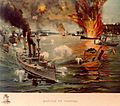Philippine Revolution facts for kids
Quick facts for kids Philippine RevolutionHimagsikang Pilipino |
|||||||
|---|---|---|---|---|---|---|---|
|
|
|||||||
|
|||||||
| Belligerents | |||||||
|
1896–1897
|
1896–1897 |
||||||
|
1898
|
1898 |
||||||
| Commanders and leaders | |||||||
|
Supremo: |
Queen Regent: Governor-Generals: (1896) (1896–1897) (1897–1898) (1898) (1898) (1898) Other leaders: |
||||||
| Strength | |||||||
| 40,000–60,000 (1896) Filipino Revolutionaries | 12,700–17,700 before the Revolution, around 55,000 (30,000 Spanish; 25,000 Filipino Loyalists) by 1898 | ||||||
| Casualties and losses | |||||||
| Heavy; official casualties are unknown. | Heavy; official casualties are unknown. | ||||||
The Philippine Revolution was a major conflict in the Philippines. It was fought between the people of the Philippines and the country of Spain. Spain had controlled the Philippines for over 300 years. The revolution aimed to gain independence for the Philippines. It is also sometimes called the Tagalog War.
The revolution started in August 1896. Spanish leaders found out about a secret group called the Katipunan. This group wanted the Philippines to be free from Spanish rule. They planned to achieve this through armed rebellion.
Contents
Starting the Fight for Freedom
The Katipunan was led by Andrés Bonifacio. This group grew very popular across the Philippines. Its main goal was to end Spain's long control.
The Call for Revolution
During a large meeting in Caloocan, Katipunan leaders formed a new government. They called it "Haring Bayang Katagalugan". They then openly declared a nationwide armed revolution. Bonifacio asked his followers to attack Manila, the capital city.
Early Battles and Victories
The attack on Manila did not succeed. However, other areas around Manila began to revolt. Rebels in Cavite province won important early battles. These rebels were led by Mariano Álvarez and Emilio Aguinaldo. They belonged to different groups within the Katipunan.
Changes in Leadership and a Temporary Peace
A struggle for power happened among the revolutionaries. This led to Bonifacio's death in 1897. Command then shifted to Emilio Aguinaldo. He became the leader of the new revolutionary government.
The Pact of Biak-na-Bato
Later that year, the revolutionaries and the Spanish signed an agreement. It was called the Pact of Biak-na-Bato. This agreement temporarily stopped the fighting. Aguinaldo and other Filipino officers went into exile. They moved to British Hong Kong in China. However, the fighting did not completely stop.
The Spanish-American War and New Allies
On April 21, 1898, the United States began a naval blockade of Cuba. This was the first military action of the Spanish–American War. The US declared war on Spain a few days later.
Battle of Manila Bay
On May 1, 1898, the U.S. Navy won a big victory. Commodore George Dewey led the US fleet in the Battle of Manila Bay. They defeated the Spanish Navy and took control of Manila.
Aguinaldo's Return and Filipino Victories
On May 19, Aguinaldo returned to the Philippines. He worked with the United States, though not officially. He restarted attacks against the Spanish forces. By June, the Filipino rebels controlled almost all of the Philippines. Only Manila remained under Spanish control.
Declaring Independence
On June 12, Aguinaldo announced the Philippine Declaration of Independence. This was meant to be the end of the revolution. However, neither Spain nor the United States recognized this independence.
End of Spanish Rule and New Conflicts
Spanish rule in the Philippines officially ended with the Treaty of Paris in 1898. This treaty also ended the Spanish–American War. In the treaty, Spain gave control of the Philippines to the United States.
Uneasy Peace and New War
There was an uneasy peace around Manila. American forces controlled the city. The Filipino forces, though weaker, surrounded them. On February 4, 1899, fighting broke out. This was the Battle of Manila (1899). It marked the start of the Philippine–American War.
Aguinaldo quickly ordered his troops to fight the Americans. In June 1899, the new First Philippine Republic officially declared war on the United States. The Philippines did not become a fully recognized independent country until 1946.
Images for kids
-
Map of the Philippines at the end of the 19th century.
-
A sketch of a Spanish galleon during Manila-Acapulco Trade.
-
Leaders of the reform movement in Spain: José Rizal, Marcelo H. del Pilar and Mariano Ponce. Photo was taken in Spain in 1890.
-
Ilustrados in Madrid, c.1890; Standing clockwise from left: Vicente Francisco, Cajigas, José Abreu, Mariano Abella, Dominador Gómez, Francisco Tongio Liongson, Flaviano Cordecruz, a Tuazon from Malabon, Alejandro Yance de Lara, Lauro Dimayuga, Marcelo H. del Pilar, Gregorio Aguilera, José Rizal, José Alejandrino, Baldomero Roxas, Moises Salvador, Modesto Reyes, Gaudencio Juanengo, Pablo Rianzares Bautista; Seated from left: Dr. Santamaria, Candido Morada, Damaso Ponce, Ariston Bautista, Pedro Serrano Lactao, and Teodoro Sandiko
-
Katipunan supreme leader Andrés Bonifacio
-
Rizal's execution in what was then Bagumbayan.
-
Emilio Aguinaldo as a field marshal during the battle.
-
Felipe Agoncillo was the Filipino representative to the negotiations in Paris that led to the Treaty of Paris (1898), ending the Spanish–American War. He has been referred to as the "outstanding first Filipino diplomat."
See also
 In Spanish: Revolución filipina para niños
In Spanish: Revolución filipina para niños






















